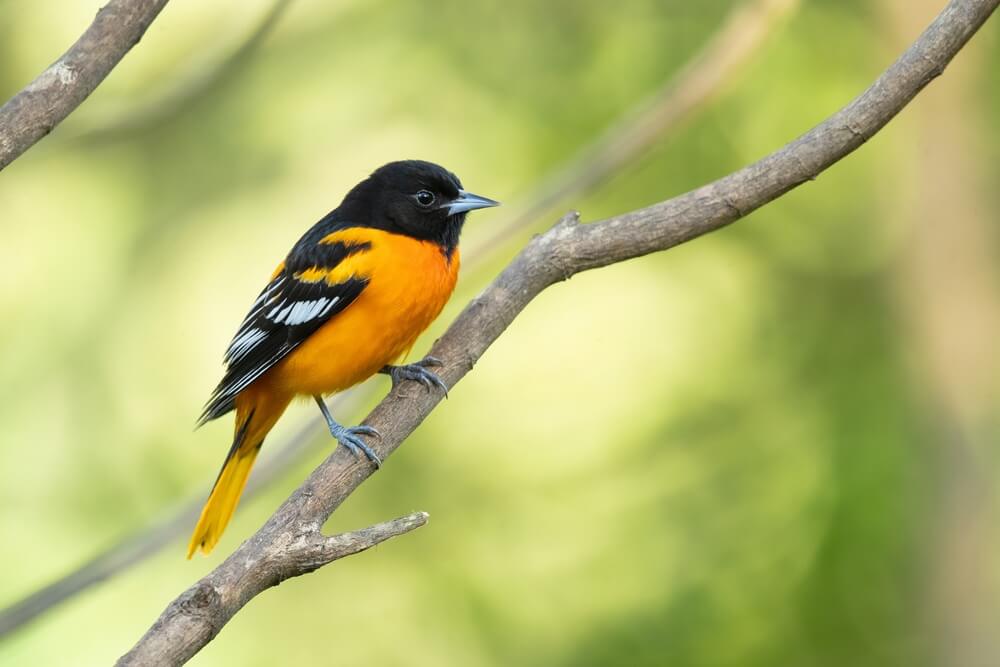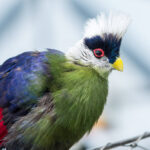The Baltimore oriole is a bright orange-flamed colored bird that is widespread east of the Great Plains. They visit open woods, groves, and backyards in the summers, seeking sugary, nectar foods and insects.
Their pouch-like nests seem to dangle precariously from thin branches, with small eggs guarded by both parents.
This article provides in-depth details about the Baltimore orioles, along with some interesting facts. Read on to learn more.
Baltimore Oriole

Overview
Scientific name: Icterus galbula
Length: 6.7 to 7.5 inches
Wingspan: 9.1 to 11.8 inches
Weight: 1.1 to 1.4 ounces
The Baltimore oriole echoes its song from treetops in the spring across eastern North America.
The male’s flame-orange feathers are a wondrous sight to see when they visit backyard feeders. These medium-sized birds have sturdy bodies with long legs and thick necks.
They are a colorful member of the family of Icterids, which includes blackbirds and cowbirds. Members of this family have long, pointed conical beaks with a thick base.
Male

Male Baltimore orioles are easy to spot with their brilliant orange feathers on their shoulders and undersides. The tail is orange and black with central black feathers.
Its head is black and the wings are black with white bars. The beak is a dusky blue and his legs and feet are gray.
Juvenile males develop their bright plumage in their second year of fall.
Female

Females and juveniles are yellow-orange on the breast. They have a brown-yellow, dark gray, or brown head and back plumage. Their wings have bold white bars.
Interestingly, females can become more orange after each molt. Therefore, older females can become nearly as bright as a male after many years of molting.
Behavior

Baltimore orioles are agile and acrobatic birds that reach the high branches of trees. Here they search for flowers, fruit, and insects.
They will also move closer to the ground to eat fruits from vines and bushes, drink nectar from flowers, and feast from backyard feeders.
As they forage they can easily move across twigs, hang upside down, and flutter, to reach food sources. They can also catch insects on the wing.
Males often sing from the treetops and paired with their vibrant orange color make them readily seen.
Baltimore orioles defend a smaller territory as compared to other birds, focusing on the area near nests. Therefore, orioles can often be seen eating near each other without fighting.
Males sing to establish breeding territories, and females will sing to communicate. Sometimes the pair of orioles will sing a duet. Their songs are clear, flute-like with single- or double-note whistled phrases.
Here is a close-up video of a male Baltimore oriole singing:
Range

Baltimore orioles can be found in the eastern and eastern-central United States. They extend as far west as Montana during breeding seasons.
In mid and late summer, migrating orioles move to winter grounds. They are found in the southeastern United States, Central America, and South America until the following April.
Diet

In the summer, Baltimore orioles primarily eat protein. This includes hairy caterpillars, beetles, grasshoppers, and wasps, as well as spiders and snails.
They also enjoy berries and fruits, feeding on natural nectar and homemade sugar water.
Baltimore orioles need higher protein sources in the summer for breeding and raising offspring. They often forage insects in American elm, maple, and cottonwood trees.
Fruits and surgery foods are consumed in greater quantities in spring and fall to have energy for migration. They tend to eat dark, ripe fruits and berries.
To feed on fruits, they use a method called “gaping”. This is when they stab the fruit, then open their mouths to pry it open and drink with specially-tipped tongues.
Habitat

Baltimore orioles spend their time in open deciduous or mixed forests. They also spend time in riverside groves, and amongst shade trees, as well as suburban parks and backyards.
They have adapted to human presence. They will visit flowering landscape plants, gardens, orchards, and backyard feeders.
They winter in the tropics near forest edges and semi-open country.
Breeding

A paired male and female are seasonally monogamous.
Males court females by hopping around them, bowing, and spreading their wings to display their bright orange back.
If the female accepts his proposal, she fans her tail, lowers and flutters her wings, and produces a chattering call.
Nesting & Chicks
A male will sing to defend a nesting territory. They both will also sound alarm calls and mob-attack after threats, such as squirrels, cats, and owls, once the eggs are laid.
The male sometimes brings the female nesting materials. The female is responsible for building a nest.
The nest is made of woven and knotted plant fibers, pieces of bark, grass, yarn, moss, old nesting materials, and man-made waste such as cellophane. It is lined with fine grasses, feathers, hair, and downy plant materials.
Nests are typically built 20 to 30 feet high in deciduous trees. It is a hanging pouch, 3 to 4 inches deep, placed at the ends of thin, forked drooping branches.
The female lays 1 brood of 3 to 6 eggs that are bluish-white or pale gray with dark markings at the larger end. She then incubates the eggs for 11 to 14 days.
Both parents will feed the nestlings, who leave the nest 11 to 14 days after hatching.
Migration

Baltimore orioles migrate at night in flocks to wintering grounds, beginning in late July and August. They land in the southeastern United States, Central America, and South America.
In April, Baltimore orioles travel north to their breeding grounds in the eastern and eastern-central United States.
Conservation

Baltimore orioles are widespread, but there has been some population decline in the past few decades. In the mid-20th century, Dutch elm disease killed many trees, which are a favorite of these orioles.
They are vulnerable to threats such as cats and owls, deforestation and habitat loss, secondary poison from insecticides, and collisions with tall man-made structures.
Overall, they remain a species of low conservation concern.
How To Attract Baltimore Orioles

To attract Baltimore orioles to a backyard, offer them ripe fruit and clean water sources (i.e. bird bath).
They like ripe, cut oranges, sugar water in oriole feeders, and small amounts of smooth natural sugar grape jelly. Fruits and jelly should not be allowed to sit out for long periods, especially in the heat.
Tubular-shaped flowers in landscaping are also attractive to Baltimore orioles. These include plants such as trumpet vine, bee balm, coral honeysuckle, and cardinal flower.
Baltimore Oriole Facts

The following are some more fun facts about the Baltimore oriole:
- Their name comes from their black and orange resemblance to the crest of England’s Baltimore family.
- The Baltimore name is also given to the city of Baltimore in Maryland, where there is a baseball team named the Baltimore Orioles.
- This species was once combined with Bullock’s Oriole under the name “Northern Oriole”, but these 2 birds are genetically different.
- Where the Baltimore Oriole and Bullock’s oriole range overlap (Great Plains), they can breed and produce hybrid offspring.











